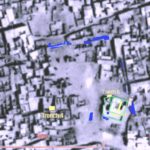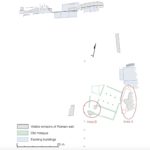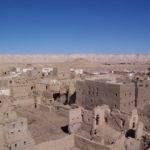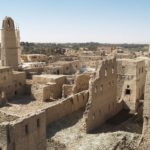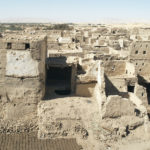QAṢR AL-DĀḪILA (KASTRA TRIMITHEŌS)
| Greek | Κάστρα Τριμίθεως |
| Coptic | pkastron Mprro |
| Arabic | قصر الداخلة | القصر |
| English | Qasr | el-Qasr |
| DEChriM ID | 18 |
| Trismegistos GeoID | 4881 |
| Pleiades ID | 776219 | PAThs ID | - |
| Ancient name | Kastra Trimitheōs |
| Modern name | Qaṣr al-Dāḫila |
| Latitude | 25.699620 |
| Longitude | 28.881454 |
| Date from | 290 |
| Date to | 1500 |
| Typology | Military camp |
| Dating criteria | - |
| Description | Qaṣr al-Dāḫila, situated 3.5km north of Amḥayda (ancient Trimithis), comprises an extensive medieval mud-brick town constructed on top of a Roman castrum, which is in all likelihood the military camp associated with Trimithis, the home base of the ala I Quadorum (Kucera 2013: 310; Ast, Bagnall 2015). In addition to the archaeological remains so-far uncovered, the castrum is attested to by papyrological documents from Kellis, ostraca found during excavations (see O.al-Qasr 4), and is described in the Fatimid period by al-Bakrī, who noted that Qaṣr had a fortress with a well located in its centre (Kucera 2013: 305; Van Leeuwen, Ferré 1992: 660). The etymology of the modern name of qaṣr supports the existence of a Roman military fort in this location. While the mud-brick Islamic buildings limit the access to the castrum, a considerable amount of information can be gleaned from these written documents. The Muslim occupation of the site is understood to span from the tenth through to the fifteenth centuries (Gardner 2012: 471; Kucera 2019: 455). The remains of the wall were first identified in 2006, situated under the courtyard and to the east of the old mosque (Leemhuis 2008: 5; Kucera 2013: 305). Remains belonging to the same structure were revealed during the 2007 excavations conducted by the Supreme Council of Antiquities (Leemhuis 2008: 5). The foundation of the wall appears to include a compact filling containing ceramic from the second and third centuries, indicating a late third century date of construction (Leemhuis 2013: 3). During the 2007 excavations by the SCA, a Coptic ostracon (O.al-Qasr 4) was uncovered, which is addressed to the ‘headmen of the imperial fort’ (pkastroN Mprro) (Gardner 2012: 473; Kucera 2013: 305). An initial staurogram and a more basic final cross attest to the Christian affiliation of the writer and perhaps the addressees (Gardner 2012: 471). Based on paleography, the ostracon can be dated to the fourth or fifth centuries, and is rather similar to a number of late fourth century documents from Kellis (Gardner 2012: 471). The association with ancient Trimithis, nowadays Amḥayda, is indicated by a number of elements. As well as the geographical proximity, documents from Amḥayda mention an associated Roman fort (Ast, Bagnall 2015: 2-3). This is in addition to the a number of decorated stone blocks uncovered at Qaṣr al-Dāḫila, which have been repurposed from the Temple of Thoth at Amḥayda (Gardner 2012: 471; Leemhuis 2013: 18, 22). Preliminary analysis of diagnostic ceramic from Qaṣr al-Dāḫila indicates third-fifth centuries dates (Kucera 2013: 309). Numerous stratified contexts where ostraca have been found include fourth and fifth century ceramics, supporting the fourth-fifth century date of the aforementioned ostracon (Gardner 2012: 472). |
| Archaeological research | The site was first surveyed by the Dakhleh Oasis Project in 1979. The Qasr Dakhla Project was then established in 2002 by the University of Groningen, under the direction of F. Leemhuis, which has conducted excavation and restoration work on the site. A total of 14 seasons have been carried out (excavation, restoration and study) as of 2015 (Leemhuis 2015: 1). |
• Ast, R., R.S. Bagnall. 2015. “New Evidence for the Roman Garrison of Trimithis.” Tyche 30: 1-4 and pl. 1-3.
• Gardiner, I. 2012. “Coptic Ostraka from Qasr el-Dakhleh.” In The Oasis Papers 6: Proceedings of the Sixth International Conference of the Dakhleh Oasis Project, edited by R. S. Bagnall, P. Davoli, C. A. Hope, 471-474. Oxford: Oxbow Books.
• Ghica, Victor. 2012. “Pour une histoire du christianisme dans le désert Occidental d’Égypte.” Journal des savants 2: 242.
• Ghica, Victor. 2016. “Vecteurs de la christianisation de l’Égypte au IVe siècle à la lumière des sources archéologiques.” In Acta XVI Congressus Internationalis Archaeologiae Christianae, Rome 22-28.9.2013, edited by Olof Brandt and Gabriele Castiglia, 241. Città del Vaticano: Pontificio Istituto di Archeologia Cristiana.
• Kucera, P. 2013. “Al-Qasr: The Roman Castrum of Dakhleh Oasis.” In The Oasis Papers 6: Proceedings of the Sixth Conference of the Dakhla Oasis Project, edited by R. Bagnall, P. Davoli and C. Hope, 305-316. Oxford: Oxbow Books.
• Kucera, P. 2019. “Observations on Some Ceramics and a Stone Vessel from the 2013 Field Season at al-Qasr.” In The Oasis Papers 9: A Tribute to Anthony J. Mills After Forty Years in Dakhleh Oasis, Proceedings of the Ninth International Conference of the Dakhleh Oasis Project, edited by G. E. Bowen and C. A. Hope, 449-458. Oxford: Oxbow Books.
• Leemuis. F. 2008. “The Dakhleh Oasis Project, the Discoveries and Conservation Work Being Done in the Old Town of Qasr Dakhleh.” Ancient Egypt 8, 4: 44–50.
• Leemuis. F. 2012. “The Qasr Dakhleh Project.” In Colours of the Oasis. Artists and the Archaeology of Dakhleh Oasis, Egypt, edited by O. E. Kaper, 43-53. Leiden: private publication.
• Leemhuis, F., N. Kucera, M. Matkowski and A. Lyzwa-Piber. 2003 “Puin ruimen in al-Qasr met onverwachte gevolgen. Voorlopige resultaten van een 'noodopgraving' in een islamitisch stadje in de Dachla oase.” Tijdschrift voor Mediterrane Archeologie 30: 29–37.
• Leemhuis, F., N. Kucera, M. Matkowski and A. Lyzwa-Piber 2005. Qasr Dakhleh Project. Research and Restoration Season 2005. https://www.monash.edu/__data/assets/pdf_file/0017/2013605/qdp-report-2005.pdf
• Leemuis. F., N. Kucera, M. Matkowski and A. Lyzwa-Piber 2007. Qasr Dakhleh Project. Research and Restoration Season 2007. https://www.monash.edu/__data/assets/pdf_file/0015/2013603/qdp-report-2007.pdf
• Leemuis. F., N. Kucera, M. Matkowski and A. Lyzwa-Piber 2008a. Qasr Dakhleh Project. Research and Restoration Season 2008. https://www.monash.edu/__data/assets/pdf_file/0014/2013602/qdp-report-2008.pdf
• Leemuis. F., N. Kucera, M. Matkowski and A. Lyzwa-Piber 2009. Qasr Dakhleh Project. Research and Restoration Season 2009. https://www.monash.edu/__data/assets/pdf_file/0013/2013601/qdp-report-2009.pdf
• Leemuis. F., N. Kucera, M. Matkowski and A. Lyzwa-Piber 2010. Qasr Dakhleh Project. Research and Restoration Season 2010. https://www.monash.edu/__data/assets/pdf_file/0012/2013600/qdp-report-2010.pdf
• Leemuis. F., N. Kucera, M. Matkowski and A. Lyzwa-Piber 2011. Qasr Dakhleh Project. Research and Restoration Season 2011. https://www.monash.edu/__data/assets/pdf_file/0014/2101622/QDP-report-2011.pdf
• Leemuis. F., N. Kucera, M. Matkowski and A. Lyzwa-Piber 2012. Qasr Dakhleh Project. Research and Restoration Season 2012. https://www.monash.edu/__data/assets/pdf_file/0013/2101621/qdp-report-2012.pdf
• Leemuis. F., N. Kucera, M. Matkowski and A. Lyzwa-Piber 2013. Qasr Dakhleh Project. Research and Restoration Season 2013. https://www.monash.edu/__data/assets/pdf_file/0015/2101623/QDP-report-2013.pdf
• Leemuis. F., N. Kucera, M. Matkowski and A. Lyzwa-Piber 2014. Qasr Dakhleh Project. Research and Excavation Season 2014. https://www.monash.edu/__data/assets/pdf_file/0018/2101626/qdp-report-2014.pdf
• Leemuis. F., N. Kucera, M. Matkowski and A. Lyzwa-Piber 2015. Qasr Dakhleh Project. Research and Excavation Season 2015. https://www.monash.edu/__data/assets/pdf_file/0017/2101625/qdp-report-2015.pdf
• Van Leeuwen, A. P. and A. Ferré. 1992. Al-Bakrī. Kitāb al-masālik wa-’l-mamālik. 2 vols. Tunis: Al-dār al-ʿarabiyya li-l-kitāb, Bayt al-Ḥikma.


 Json data
Json data